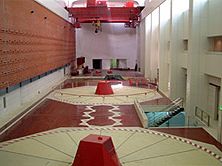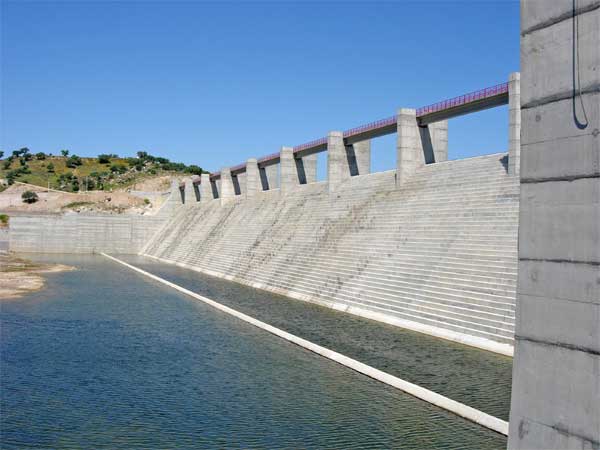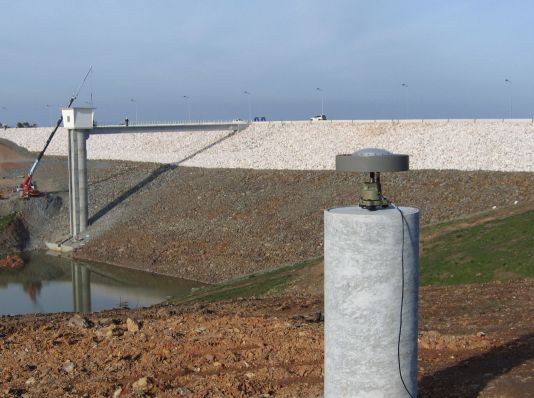



The Alqueva Multipurpose Project (AMP) is situated in the region of Alentejo,
one of the most under-developed and
backward regions in Portugal and Europe, with an area of 27 000 Km (nearly a third of
continental Portugal) and approximately 500 000 inhabitants. This large area, with a rich
and diversified natural patrimony, presents important problems in terms of physical and
human desertification.
The first references to create a water reserve in the Guadiana River in the Alentejo
region, were made 100 years ago, but the project, as long as it concerns to the AMP,
was conceived in 1957 as part of the Alentejo Irrigation Plan. However the Project
was only approved in 1975, after the Portuguese-Spanish Agreement in 1968. This
Agreement attributed to Portugal the hydraulic exploration of the international section
of the Guadiana River between the confluence of the Caia River and Cuncos brook. It
was agreed that a dam would be built in Alqueva and in 1976 the construction works
have started. The preliminary works lasted for only 2 years, the time to build the
downstream and upstream coffer-dam, the deflection stream river provisional tunnel,
accesses and support infrastructures. The works were interrupted in 1978, a new
evaluation process started, and new studies were promoted. Later in 1993, the
Portuguese Government decided to resume the Project and the works in Alqueva
restarted in 1995. In 1996 the new Government elected in 1995 decided to proceed
with the AMP with or without financial support from the EU. Recently, on February 8
th, 2002 the dam gates were closed and the Alqueva reservoir started to fill up.
Project Objectives:
- The setting up of a strategic water reserve in the Alentejo region;
- Providing a guarantee of water supply to populations and industry;
- Progressing change of the crop model in Alentejo's agriculture;
- Electricity production;
- The development of tourism;
- The combat against physical desertification and climate changes;
- Organized intervention in the domains of the environmental and national heritage;
- Encouragement of the regional employment market.
The AMP includes the following infrastructures:
| - Alqueva, a concrete dam (maximum height of 96 m), one of the biggest dams
in the Iberian Peninsula,
has created the biggest artificial lake in Europe. The lake has
an area of 250 km2
(35 km2 in Spain), a length of approximately 83 Km,
a perimeter of 1 100 Km and a total capacity of 4150 hm3, of which 3150 hm3
are usable during regular operation; | 
|
|---|---|
| - Hydroelectric plant of the Alqueva dam, with two turbine/pump groups with 120MW of power each, and a total electricity production capacity of 350GW/hour/year; | 
|
| - Pedrogão, a roller-compacted concrete dam, located 23 km downstream of Alqueva dam, with a full storage level at 84,8 m (maximum height of 39 m) and a usable volume of 54 hm3. This dam is used to pump part of the water to the Alqueva dam, maximizing the electricity production; | 
|
| - Nine new embankement dams; | 
|
| - Adducting system for water supply to populations, industry and agriculture, composed by a net of canals and pipelines (about 5 000 Km); |
The Alqueva irrigation plan includes:
- 17 dams (including nine new ones)
- the Alamos elevatory station
- 680 km of primary irrigation channels
- 4400 km of secondary and tertiary irrigation channels.
In this global system of irrigation is included a water transfer system between basis, from Guadiana
Sado, since a large part of the future irrigated lands is planned for
Sado Basin. The global system of irrigation is divided into three sub-systems:
-Alqueva (right margin of Guadiana River): 71 000 ha, irrigated from Alqueva reservoir and
nearly 8 000 ha from high Alentejo dams system.
-Pedrogão (right margin of Guadiana): 29 000 ha, irrigated by the Pedrogão
reservoir.
-Ardila (left margin of Guadiana): 11 000 ha, irrigated by the Pedrogão reservoir.
The Alqueva Multipurpose is manage by EDIA (Empresa de Desenvolvimento e Infra-estruturas do Alqueva -
Alqueva Development and Infrastructures Company)